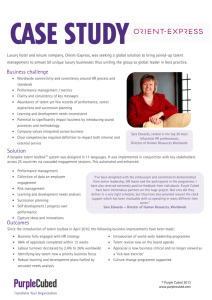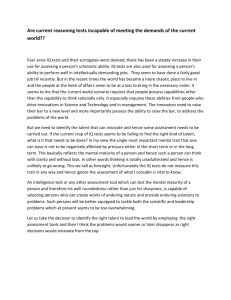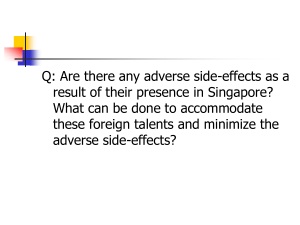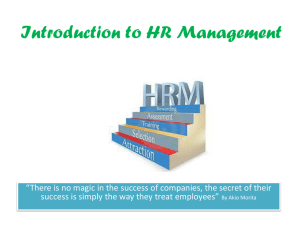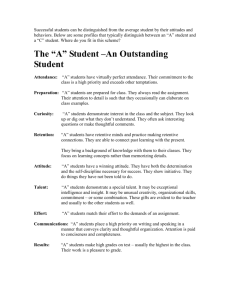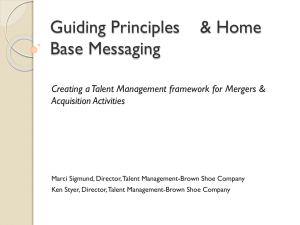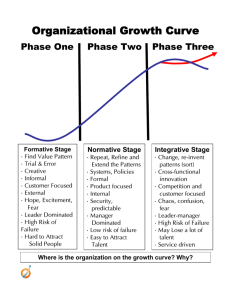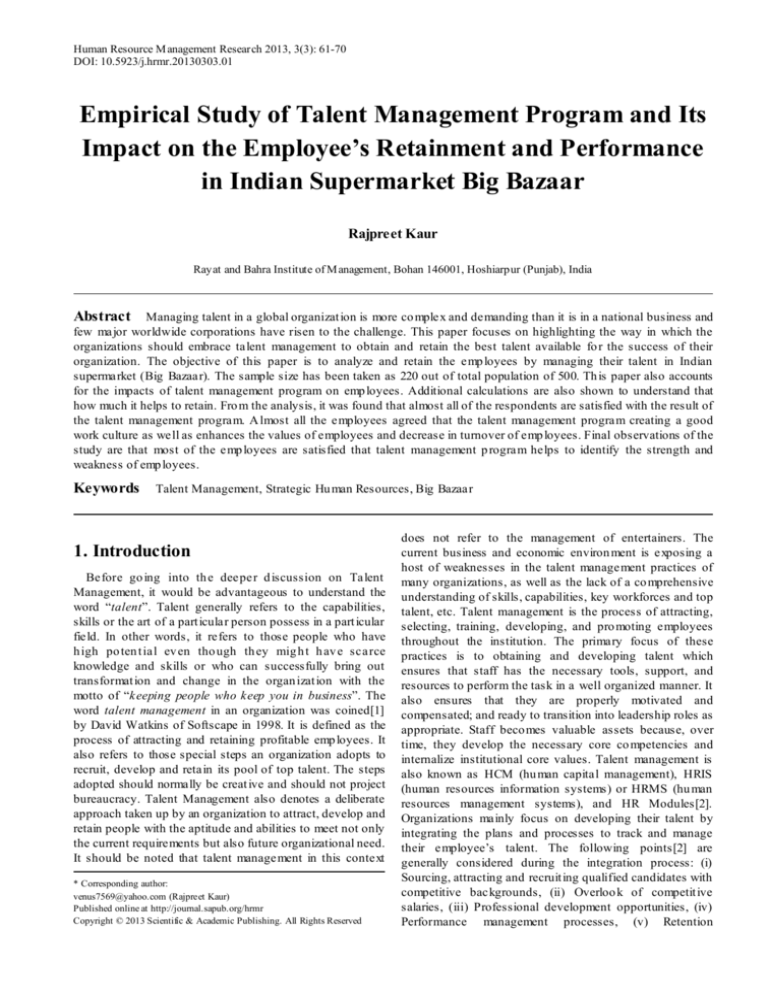
Human Resource M anagement Research 2013, 3(3): 61-70
DOI: 10.5923/j.hrmr.20130303.01
Empirical Study of Talent Management Program and Its
Impact on the Employee’s Retainment and Performance
in Indian Supermarket Big Bazaar
Rajpreet Kaur
Rayat and Bahra Institute of M anagement, Bohan 146001, Hoshiarpur (Punjab), India
Abstract Managing talent in a global organizat ion is more co mplex and demanding than it is in a national business and
few major worldwide corporations have risen to the challenge. This paper focuses on highlighting the way in which the
organizations should embrace talent management to obtain and retain the best talent available fo r the success of their
organization. The objective of this paper is to analyze and retain the emp loyees by managing their talent in Indian
supermarket (Big Bazaar). The sample size has been taken as 220 out of total population of 500. Th is paper also accounts
for the impacts of talent management program on emp loyees. Additional calculations are also shown to understand that
how much it helps to retain. Fro m the analysis, it was found that almost all of the respondents are satisfied with the result of
the talent management program. A lmost all the employees agreed that the talent management program creating a good
work culture as well as enhances the values of employees and decrease in turnover of emp loyees. Final observations of the
study are that most of the emp loyees are satisfied that talent management p rogram helps to identify the strength and
weakness of emp loyees.
Keywords
Talent Management, Strategic Hu man Resources, Big Bazaar
1. Introduction
Before go ing into th e deeper d iscussion on Talent
Management, it would be advantageous to understand the
word “talent”. Talent generally refers to the capabilities,
skills or the art of a part icular person possess in a part icular
field. In other words, it refers to those people who have
h igh po ten t ial ev en tho ugh th ey mig h t h av e scarce
knowledge and skills or who can successfully bring out
transformat ion and change in the organ izat ion with the
motto of “keeping people who keep you in business”. The
word talent management in an organization was coined[1]
by David Watkins of Softscape in 1998. It is defined as the
process of attracting and retaining profitable emp loyees. It
also refers to those special steps an organization adopts to
recruit, develop and retain its pool of top talent. The steps
adopted should normally be creat ive and should not project
bureaucracy. Talent Management also denotes a deliberate
approach taken up by an organization to attract, develop and
retain people with the aptitude and abilities to meet not only
the current requirements but also future organizational need.
It should be noted that talent management in this context
* Corresponding author:
venus7569@yahoo.com (Rajpreet Kaur)
Published online at http://journal.sapub.org/hrmr
Copyright © 2013 Scientific & Academic Publishing. All Rights Reserved
does not refer to the management of entertainers. The
current business and economic environ ment is exposing a
host of weaknesses in the talent management practices of
many organizations, as well as the lack of a co mprehensive
understanding of skills, capabilities, key workforces and top
talent, etc. Talent management is the process of attracting,
selecting, training, developing, and pro moting employees
throughout the institution. The primary focus of these
practices is to obtaining and developing talent which
ensures that staff has the necessary tools, support, and
resources to perform the task in a well organized manner. It
also ensures that they are properly motivated and
compensated; and ready to transition into leadership roles as
appropriate. Staff beco mes valuable assets because, over
time, they develop the necessary core co mpetencies and
internalize institutional core values. Talent management is
also known as HCM (hu man capital management), HRIS
(human resources information systems) or HRMS (hu man
resources management systems), and HR Modules[2].
Organizations mainly focus on developing their talent by
integrating the plans and processes to track and manage
their employee’s talent. The following points[2] are
generally considered during the integration process: (i)
Sourcing, attracting and recruit ing qualified candidates with
competitive backgrounds, (ii) Overloo k of competit ive
salaries, (iii) Professional development opportunities, (iv)
Performance management processes, (v) Retention
62
Rajpreet Kaur: Empirical Study of Talent M anagement Program and Its Impact on
the Employee’s Retainment and Performance in Indian Supermarket Big Bazaar
programs, and (vi) Pro motion and transitioning, etc.
Key[3] discussed that talent management helps
supermarket chain live brand pro mise. Key[3] detailed that
united
supermarket ’s
learning
and
performance
management strategies help the company increase employee
engagement, maintain costumer loyalty and control the cost.
Key[3] summarized as “We believed our growth and
success are tied to our commitment to service. By aligning
our talent management processes to support this
commitment, and using the right technology solution, we
are more capable than ever of living to our brand promise
throughout the organization”. Keeping in the views of
Key[3] and talent management practices, this paper focuses
on highlighting the way in which the organizations should
embrace talent management to obtain and retain the best
talent available for the success of their organization. It
accounts for the impacts of talent management program on
emp loyees. The broad objective of the study is to analyze
the talent management program of big bazaar (one of the
Indian supermarket) and its impact on the e mp loyees.
Additional analysis has also been done to investigate the
satisfaction of emp loyees with TMP and theirs retaining
strategies.
individual and organizational v ision. Talent manifests into
performance as shown in Figure 1. Thus, in addition to the
overall develop ment of individual’s intrinsic capacities, the
domain of talent management also focuses on better
working environ ment and positive changes in the
management to provide the other elements listed above for
man ifestation of talent into performance. In general, talent
management programs (TMP) aims to accomplish the
following[5,6]:
● To provide a holistic view of the indiv idual: current
and future.
● To help in identifying and preparing future leadership
talent.
● To provide key resources with recognition and
growth opportunities.
● To facilitate retention of high performers.
● To help identify and groo m potential develop ment
plans.
● To co mp lement the rewards system.
2. Importance of Talent Management
Program in Organization
Talent management brings together a number of
important human resources and management in itiatives.
Quite often, organizations adopting a talent management
approach will focus on co-coordinating and integrating of
the following strategies[4]:
● Recru it ment - ensuring the right people are attracted
and employed in the organization.
● Retention - development and imp lementation
practices that reward and support employees.
● Professional develop ment - ensuring continuous
informal and formal learning and development.
● Advanced leadership and development - specific
development programs for existing and future leaders
having strong potential toward the organizat ion.
● Performance management - specific processes that
nurture and support performance, including feedback /
measurement.
● Workforce planning - p lanning for business and
general changes, including the older workforce and
current/future skills shortages.
● Culture - development of a positive, progressive and
high performance “way of operating”. An important step is
to identify the staff or emp loyees (people and positions) that
are critical to the organizat ion. They do not necessarily have
to be senior staff members.
With the help of the above detailed integration process as
a part of the talent management progra m, organizations
provide individuals the opportunity and space for physically
man ifesting their talent into performance for achieving
Figure 1. A pictorial representation of steps in conversion of talent to
performance
The supply side puts pressure on organization to attract
the best talent and ensure that employees join the company
and choose to stay in the o rganizat ion rather than look for
opportunities elsewhere. In the recent days, the human
resources department of any organization is vested with the
responsibility of managing the talent, in addition to its
conventional function of providing good human capital to
an organization. In order to perform this function, they use
the following methods:
1. Identifying the suitable talent
2. Right selection of the talent
3. Imp lementing competit ive co mpensation plans
4. Training and continuous development of co mpetencies
5. Practicing state-of-the–art performance appraisal
systems
Human Resource M anagement Research 2013, 3(3): 61-70
6. A ligning the acquired talent
7. Developing and nurturing the talent, and
8. Retain ing the talent
3. Background Review
Over the years, considerable research efforts have been
put into the development and imp lementations of talent
management program. The available literature reveals that
organizations have focused on talent management and
understood that talent management is aligned to the
emp loyees with the mission and vision of the organization
which ends up with better results to their organizations. A
voluminous body of informat ion has emerged in the
literature (journal articles, text books, handbooks, websites,
etc.). For instance, a survey on the global talent
management practices conduced by the Industrial Relations
Consellor’s Inc[7,8] reported that the assessment processes
with open and frank discussion are seen to one of the most
effective process in identifying the suitable talent. It was
also mentioned that many of the mult inational co mpanies
explicit ly seek and encourage diverse workforce in their
talent pools. Lewis and Heckman[9] in their critical review
of talent management discussed the some of the basic
questions like what is talent management and what does it
have in scientific principles of hu man resources and
management? They addressed such question by reviewing
problems with the definit ion of talent management and the
lack of data supporting many practit ioner claims. Based on
responses of above questions, they proposed a way which
supports a systems oriented definit ion of talent management
that focuses on the strategic management of talent. They
also outlined future avenues of research to further develop
the field of talent management and t ie it mo re closely to the
large volu me of work in strategic hu man resources
management. The best practices in the talent management
are documents in a recent book[10]. It includes the most
up-to-date thinking tools, models, instruments and case
studies necessary to identify, learn and manage the talent
within the organizat ion with the focus on the results. It also
provides the way to put the thought leadership into the
real-world pract ices. More
recently, the
most
comprehensive book on talent management[11] exp lains
how organizat ions can identify and hold onto their most
valuable employees. It also suggests how to get the most
out of high potential people by developing and promoting
them to the key positions in the organizations.
Approachable human resources strategies tied with the
business success measures are discussed in this
handbook[11]. It thoroughly integrates the key elements of
human resources assessment (performance, potential,
competencies, career planning, and succession planning)
into a cogent system that can be utilized by both managers
and human resources professionals in realizing organization
success. Subsequently, Effron and Ort[12] presented a
revolutionary approach on talent management practices.
63
They argued that the organizations unwittingly add layers of
complexity to their talent build ing models–without
evaluating whether those component provide any added
values to the overall p rocesses. Consequently, simp le
processes such as setting employee performance goals
become mu lti-page, headache-inducing time-consuming
which turn managers off to the whole process and fail to
improve results. Overall, this book provides a good
overview of the key areas of the talent management which
may significantly enhance the credib ility of hu man
resources. McDonnell et al.[13] utilized data fro m 260
mu ltinational enterprises to re-address the deficit
“organizations are becoming relentless in managing and
developing their key talent”. They exp lored the extent to
which mu ltinational enterprises engage in global talent
management and decipher some of the factors which may
explain the appropriateness of usage of global talent
management practices. They found that although a
significant number of mu ltinational enterprises have
systems and mechanis ms in p lace to strategically identify
and develop their talent many mo re seemingly adopt an
ad-hoc or haphazard approach. For instance, less than 50%
of all mu ltinational enterprises have both global succession
planning and formal management develop ment programs
for their h igh potentials. More recently, Gopal and Vij[14]
discussed talent management practices in the Indian
informat ional technology industries. Piansoongenern et
al.[15] studied the strategies of the talent management in
Thai cement co mpanies. Their investigation focused on the
factors influencing employees engagement.
In summary, there have been great efforts on
identification, imp lementations and planning of the talent
management practices. As much as known to the author,
none of the study has exp lored the talent management
practices and its impact on the employees of the Indian
supermarkets. Therefore, the present study is aimed to find
out the existing Indian talent scenario in the big bazaar to
analyze its emerging challenges and trends. The sample size
has been taken as 220 out of the total population of 500.
The talent management program p rocess is applicable to all
emp loyees in big bazaar who have been emp loyed for at
least six months tenure in the organisation as on-roll
emp loyee.
4. Limitations of the Study
Since this study requires survey in the various super
markets (big bazaar’s) and the emp loyees are directed not to
give much informat ion. They are also quite busy with their
duties. There are certain limitations of the study as listed
below:
1. This study was done in the organization and the
respondents were busy. The respondents filled up the
questionnaire in between their busy schedule.
2. Employees responded according to their own
perceptions.
64
Rajpreet Kaur: Empirical Study of Talent M anagement Program and Its Impact on
the Employee’s Retainment and Performance in Indian Supermarket Big Bazaar
3. Due to the mediu m scale organization (big bazaar,
Indian supermarket), samp le size of 50 or less was possible
fro m a single organizat ion. The sample size has been taken
as 220 out of total population of 500.
4. Emp loyees fear to disclose the information as company
has not allowed disclosing confidential information.
5. Employees are less educated which results in the lack
of knowledge.
6. Time factors (i.e., working hour of employees or shift
timings, etc.) was the major limitation of this survey.
7. Availability of the emp loyees (including absenteeism)
at the particular t imings of the survey was another concern
while collecting the data.
8. Since not many emp loyees work for a long time with
such type of organizations, the talent management program
analysis used herein this study is applicable to all
emp loyees of big bazaar who have been employed therein
for atleast of 6 months tenure as on-roll emp loyee. This, in
turn, also reduces the sample size fro m an indiv idual b ig
bazaar’s.
5. Research Design and Methodology
The present study is descriptive in nature as it attempts to
understand the employee’s opinion regarding the talent
management program of the Big Bazaar. To fulfill this
purpose, a closed-end questionnaire (see the Appendix –I)
was prepared with questions on employee’s demographic
profile and on the specific talent management program. The
questionnaire has been properly prepared in order to cover
all the specific Information required for the study.
(a) Primary source of data: The primary data has been
collected through the questionnaire. The primary data has
been obtained by scheduled and structured interview with
the officers and staff in the different div ision of the Big
Bazaar as well as through the questionnaire distributed to
the emp loyees in different depart ments in that particular
division of Big Bazaar.
(b) Secondary sources o f data: As per the standard
practices used in this type of studies, secondary data is
collected fro m various books available in the library. Due to
the growing importance and availability of various journal
and periodical related to the talent management are also
referred for the data collection and validation purpose.
Additional sources being the magazines published
electronic resources and general website for the suitable
secondary data collection. All the electronic sources of data
collection are chosen based on their reliab ility check and
analysis fro m various references. In addition to all the
secondary sources mentioned above, some of specimens of
company and company website are also referred in this
study.
(c) Sampling plan: In this work, universal sampling
method is used to collect to analyze the information’s.
Universal samp ling fro m a finite population refers to the
method of sample select ion which gives each possible
sample co mb ination an equal probability of being picked up
and each item in the entire population to have equal chance
of being included in the sample.
The sample size of 220 (out of 500 total populations) was
chosen for this study fro m the part icular div isions of Big
Bazaar’s. Keeping in view of the objectives as well as
limitat ions of this study, an objective type questionnaire
(see Appendix - I) was distributed to 220 persons for the
sample and collected different opinions and ideas of the
emp loyees of the Big Bazaar.
(d) Sampling techniques: As mentioned in the sources of
primary data, the sampling techniques used in this research
were non-probability convenient sampling techniques. The
survey was conducted through questionnaire and scheduled
interview with in the various Big Bazaars located in Punjab
state (India).
(e) Hypothesis: Having collected the sufficient
informat ion fro m the various primary and secondary
sources, the following hypotheses were used in this study:
● Null hypothesis includes the following points for the
talent management system:
○
Emp loyee’s taking benefits fro m talent
management programs
○ Employee’s are retained successfully for the
benefit of the organizat ion
○ Enhancement in the emp loyee’s performance by
the talent management
○ In fluence of the procedural imp lementation of this
program on the turnover of the organizations.
● Alternate hypothesis covered the fo llo wing points for
the talent management system:
○ Emp loyees are unable to take benefits fro m the
talent management system
○ Emp loyees are not retained successfully for the
benefits of the organization
○ No alternation in the employee’s performance due
to the program
○ Turnover of the organization not influenced with
the talent management program.
6. Data Analysis and Interpretations
Having obtained all the required informat ion fro m the
various sources of data collection, data analysis was done. It
is a process of breaking down a complex set of facts into
simp le element. Date analysis is followed by an
interpretation wh ich stands for the exp lanations which
analyzed the statements and also make out or bring out the
mean ing of creat ive wo rk. It is expected that such analysis
and interpretation will defin itely help the co mpany in their
future strategic planning’s. As per questionnaire, the data
analysis and interpretations have been explained herein in
step wise.
(i). Identificati on of working period in the
organization: The first question of the survey was to look
out for the stability of emp loyees in the Big Bazaar’s.
Human Resource M anagement Research 2013, 3(3): 61-70
Figure 2 su mmarizes the respondent status based on their
emp loyment period in the o rganizat ion obtained fro m the
primary sources.
>5
8%
2–5
22%
<1
40%
65
determine the weakness or strength of the emp loyees.
About 40% of the participant employees strongly agreed
with the talent management program at the same t ime 40%
agreed with it. 12% of part icipated employees responded in
a neutral way that they are not clear about the positive side
of the talent management program and whether it can really
helps them to identify the strength and weakness of the
emp loyees. On the other hand, s mall nu mber o f part icipants
(about 6%) did not agree with the concept of talent
management program whereas negligib le number of
participants (2%) were strongly disagree with the scope of
the program in indentifying the strength and weakness of
the employees.
No decision taken
6%
Making changes in
dissatisfaction areas
6%
1–2
30%
Figure 2. Identification of working period of the employees of the big
bazaar
Change in motivating
strategy
36%
It was observed that the more than 60% employee’s, who
were part of the survey, has been working in the Big
Improvement in the
Bazaar’s for more than one year. It can be observed from
management employees
Figure 2 that 40% o f emp loyees were new appointed and
relationship
Restructure of
44%
have been working in the organizat ion for less than one year,
organization or
30% emp loyees have been working therein for 1 to 2 years,
individual objectives
8%
22% emp loyees have worked for mo re than 2 years but less
than 5 yrs and the remain ing 8% employees have been Figure 4. Influence of talent management program on the strategic
changes in the organization
working for the period longer than 5 years.
Strongly disagree
2%
Disagree
6%
Neither agree nor
disagree
12%
Strongly agree
40%
Agree
40%
Figure 3. Identification of strength of talent management program
(ii). Strength and weakness of the talent management
program: Figure 3 su mmarizes the strength and weakness
of the talent management programs being applied in the Big
Bazaar. It can be observed the large number of part icipants
(about 80%) agreed with the imp lementation of the talent
management program and its positivity in the strength
development of the employees. It also suggests that the
talent management program, in general, helps us to
(iii). Influence of the talent management on the
strategic changes in the organizati on: An analysis of
Figure 4 suggests that largest number (44%) o f participated
emp loyees experienced an improvement in the management
and emp loyees relationship due to the talent management
program. Almost equal but little less number (36%) of
participants were in agreement with the change in the
motivational strategic (both monetary and non-monetary)
which helps for the development of the employees and as
well as for the organization. All these affects were due to
the proper implementation of the program. The above two
responses in terms of the management and employees
relationship and strategic development of employees and
organization were clearly due to the employees who have
spent longer work period in the Big Bazaar. Restructuring
of organization or indiv idual elements in the organization
due to the talent management have also been experienced
by about 8% of the respondent. The 6% of the respondent
agreed with the possible changes in the area’s of
dissatisfaction of employees of the organization. The
remain ing 6% of the participants were in in-line with the
talent management and responded that no decision making
is possible due to the bound to the limitations or
shortcomings of talent management program.
66
Rajpreet Kaur: Empirical Study of Talent M anagement Program and Its Impact on
the Employee’s Retainment and Performance in Indian Supermarket Big Bazaar
Not at all important
4%
Most important
15%
Less important
42%
Very important
39%
Figure 5. Usefulness of talent management program in the employee’s
performance
Standards
24%
Employee Development
52%
Monetary incentives
10%
participants (52%) were in agreement with the employees
overall development due to the talent management practices.
Small nu mber (10%) of participants also responded that
talent management helps them in terms of the monetary
incentives; however, 14% emp loyees were looking forward
about the appraisal gains due to the talent management. All
in all, most of the participants were possible in one or other
way of the improvements in the emp loyees results due to
the talent management program.
(vi). Effecti veness of the talent management on the
empl oyee’s potential advancement: Figure 7 represents
the effectiveness of the talent management on the
emp loyee’s potential development. The response was
obtained in four levels, i.e., highly effect ive, effect ive,
neutral or ineffective. It is seen from the figure that the
large population responded in the positive manner, i.e.,
about 28% of the employees felt that the talent management
programs adopted by the big bazaar are highly effective for
their potential advancement. A long the same line, about
40% of employees are in agreement of effectiveness of such
programs. Over all, about 68% of the respondents were
positive about the effectiveness in the employee’s potential
development. Like all other surveys, about 24% of the
respondent were neutral in their response, however, very
small fraction (8%) of the participants were not at all in the
agreement with the effectiveness of the talent management
program in their potential advancements.
Ineffective
8%
Appraisal
14%
Highly effective
28%
Figure 6. Importance of the talent management in the improvement of
particular areas
(i v). Usefulness of the talent management in the
empl oyee’s performance: It can be observed from Figure 5
that the responses in relation to the usefulness of the
program in the performance of the emp loyees are also in
accordance with the response to previous items of the
questionnaire. In general, above 50% of the participated
emp loyees agreed with the ro le of talent management
program and its usefulness in the enhancement of their
performance. 15% of the part icipants were in strong
agreement that the talent management program is most
important to develop their performance. Ho wever, 39% of
the participants responded that talent management plays a
very important role in enhancing their performance. On the
other hand, about 42% of the emp loyees did not agree and
responded that talent management is less important in this
aspect whereas 4% suggested that talent management is not
at all important in their performance.
(v) Importance of the talent management in the
improvement of particul ar areas: It can be observed from
Figure 6 that most of the respondent felt that the talent
management program can bring improvements in one or
another area of employees or organizational interests. For
instance, about 24% of the participants responded about the
standard improvements, in general whereas large nu mber of
Neutral
24%
Effective
40%
Figure 7. Effectiveness of the talent management on the employee’s
potential advancement
(vii). Identification of empl oyee’s moti vating factor
towards the work environment: Figure 8 identifies the
motivating scale of the talent management on the
emp loyee’s work environ ment. Similar to the previous
discussions, here also, it can be seen that about 28% of the
participants were highly motivated and about 52% of the
emp loyees were fairly mot ivated towards their work
environment wh ich was due to the proper implementation
of talent management practices. The survey suggests that
small number of part icipants (about 16%) remained neutral,
Human Resource M anagement Research 2013, 3(3): 61-70
however, 4% of the participants were negative in terms of
the motivating factor.
(viii). Co-operation and team work due to the talent
management program: Figure 9 identifies whether the
talent management program helps to win co-operation and
team work among the employees of the organization. The
response of the participants in this regards was fairly
positive. For instance, 38% of the participants felt that the
talent management program helps them very frequently, on
the other hand, 32% responded that its helps them
occasionally to easily cooperate and team work. A lmost
equal number of participants felt that they rarely (17%
participants) or never (13% part icipants) get any positive
help in winning up cooperation and team work. Overall,
there is also win-win situation of talent management
program.
De-motivating
4%
Neutral
16%
Highly motivating
28%
Fairly motivating
52%
Figure 8. Identification of employees motivating factor towards their
work environment
Never
13%
Frequently
38%
Rarely
17%
Everyone
8%
Human Resource
Department
28%
Supervisor/manager
40%
Senior leadership
24%
Figure 10. Responsibility for talent management program and employees
engagement in the organization
(ix). Responsi bility for talent management program
and its empl oyee engagement in the org anization: The
study also exp lored whether the participants understand that
who is responsible for the talent management and its
emp loyee’s engagement in the organization. In the survey
(Figure 10), about 28% of the participants replied that
human resources department is responsible for such type of
the activities with the organizat ion. Almost equal nu mber of
participants (i.e., 24%) thought that senior leadership of the
organization has to take care of this responsibility. The
large nu mber of participants (about 40%) rep lied that the
supervisors and managers are responsible in proper
implementation of talent management program and its
emp loyee’s engagement in the organization. Ho wever, very
small fraction (about 8%) of the employees think that each
and every individuals working for the organization has to
take the responsibility of proper and successful practices of
the talent management.
Identifying gaps in
current employees and
candidate competency
levels
10%
Creating an environment
where employees ideas
are listened to and valued
24%
Creating an environment
where employees are
excited to come to work
each day
20%
Occasionally
32%
Figure 9.
program
Co-operation and team work due to talent management
67
Aligning employees with
the mission and vision of
your organization
18%
Creating a culture that
makes employees want to
stay with the
organization
14%
Creating a culture that
values employees work
14%
Figure 11. Suggestion to improve the talent management program of the
big bazaar
(x). Suggestions to improve the talent management
program in the big bazaar: Finally, the suggestions are
also collected through the survey to improve the talent
management program in the big bazaar. Figure 11
summaries the fract ion of various suggestions asked in
68
Rajpreet Kaur: Empirical Study of Talent M anagement Program and Its Impact on
the Employee’s Retainment and Performance in Indian Supermarket Big Bazaar
questionnaire. It can be seen that the largest number of
emp loyees (24%) suggested that the organizat ion should
create an environment where the emp loyee’s ideas are listed
and valued in the proper way. It is also suggested by 20% of
the employees that the organization should create an
environment where emp loyees are excited to come to work
each day. About 18% of the part icipants said that the
organization should align their emp loyees with the mission
and vision layouts. Equal number o f participants (14%)
suggested that organization should create a culture which
makes employees to stay with organizat ion and also the
emp loyees work should be valued in appropriate manner.
About 10% o f the part icipants suggested identifying the
gaps in current emp loyees and candidate competence levels.
Over all, the suggestions are very much appreciated by the
author.
7. Summary of the Observations
Fro m the analysis shown in the previous section, it was
found that almost all of the respondents are satisfied with
the result of the talent management program. Almost all the
emp loyees agreed that the talent management program
creating a good work culture as well as enhances the values
of employees and decrease in turnover of employees. Final
observations of the study are as follow:
● Train ing roo m, education, mentoring and coaching
are usually used by the organization to carry out talent
development activities
● Most the employees have a clear knowledge about the
company’s vision, mission and objectives. And they know
how to achieve these objectives.
●
Employees are clear about their ro le and
responsibilit ies.
● Almost all of the respondents are satisfied with the
result of the talent management program (changes in the
organisation).
● Almost all the emp loyees are agreed that due talent
management program, creating a good work culture as well
as increase the values of employees, decrease in turnover of
emp loyees.
● Most of the employees are satisfied that talent
management program helps to identify the strength and
weakness of emp loyees.
● Improvement in personal skills of employees,
emp loyee’s relationship in the organisation.
8. Concluding Remarks
As organizations continue to pursue high performance
and improved results through talent management program,
they are taking a holistic approach to talent management –
fro m attracting and selecting wisely, to retain ing and
developing personal skills of emp loyees, to increase the
confidence of emp loyers, to placing employees in positions
of greatest impact. Therefore, every organization want to
grow and imp rove their systems and processes, so Big
Bazaar must focus on the employee’s performance and
potential or emp loyees practices the allow or foster that
growth and improvement through known best practices of
the talent management program. The key variables
(leadership co mpetencies, experience, personal skill,
emp loyee’s interest, and rewards) that motivate emp loyees
to succeed have been identified and successfully put into
practice. It is a v iable path toward improving organizat ional
performance
9. Recommendations
Based on the analysis conducted in the organizat ion, the
following reco mmendations are made to the organization:
● As some of the employees are not agreed with results
of the talent management program and talent management
program is very important for developing the emp loyee’s
skills, so the organization has to take some more steps to
improve the job environ ment and working conditions.
● So me of emp loyees get de-motivated with the result
of talent management program, so organization should
undertake those activities so that employees should get
motivated.
● Div isional manager of the organizat ion should create
the full confidence in the agents/employees of the
organization.
● So metimes quite difficu lt to identify the talent of
number of emp loyees in the organization, so divisional
manager/supervisor of that organizat ion should divide the
emp loyees/agents into the groups so that they can easily
identify exact talent of the employees.
● Manager should undertake interesting activities so
that hidden talent of employees can be improved.
● The relationship b/w agents/employees and manager
with in the organizat ion should be clear, so that agents can
easily transfer the employees problems to manager without
hesitation.
Annexure
Questionnaire for Talent Management Program of
Emp loyees of Big Bazaar
Emp loyee code
Emp loyee Designation_____
Q. 1. How long you have been working in the
organization?
a) Less than 1 yr
b) 1-2 yrs
c) 2-5 yrs
d) More than 5 yrs
Q. 2. Do you think Talent Management Program
helps to identify the strength and weakness of
emp loyees?
Human Resource M anagement Research 2013, 3(3): 61-70
a) Strongly agree
b) Agree
c) Neither agree nor d isagree
d) Disagree
e) Strongly disagree
a) Hu man Resource Depart ment
b) Senior leadership
c) Supervisor/ manager
d) Everyone
Q. 10. Suggestions your organization needs to
improve the most in terms of Talent Management
Program? (Choose Any One)
Q. 3. What changes have taken place in the
organization as a result of Talent Management
Program?
a) Aligning employees with the mission
and vision of your organization
b) Creat ing a culture that makes
emp loyees want to stay with the
organization
c) Creating a culture that values
emp loyees work
d) Creat ing an environment where
emp loyees are excited to come to work
each day
e) Creating an environment where
emp loyees ideas are listened to and
valued
f) Identifying gaps in current
emp loyees and candidate competency
levels
a) Change in motivating strategy
b) Restructure of organizat ion or
individual object ives
c) Improvement in the management
emp loyees relationship
d) Making changes in dissatisfaction
areas
e) No decision taken
Q. 4.How it is useful for your performance?
a) Not at all impo rtant
b) Less important
c) Very impo rtant
d) Most important
Q. 5. According to you which areas improved due
to this Program?
a) Standards
b) Monetary incentives
c) Appraisal
d) Employee Development
Q. 6. How it becomes effective to identify
emp loyee’s potential for advancement?
a) Highly effective
b) Effect ive
c) Neutral
d) Ineffect ive
Thank you for filling up the questionnaire…
REFERENCES
[1]
Uba C. (2011). Talent management strategy. Business World
Intelligence. http://businessworldng.com/web/articles/1739/
1/Talent-M anagement-Strategy/
[2]
Bryan, L., Joyce, C. and Weiss, L. (2006). M aking a market
in talent. McKinsey Quarterly, 2.
[3]
Key C. Talent management helps supermarket chain live
brand promis e. http://www.cornerstoneondemand.com/talent
-management-helps-supermarket-chain-live-brand-promise
Q. 7. To what extent is Talent Management
[4]
Program mot ivating the work environ ment?
a) Highly mot ivating
b) Fairly motivating
c) Neutral
d) De-mot ivating
Q. 8. In your opinion does Talent Management
Program helps to win co-operation and team work?
a) Frequently
b) Occasionally
c) Rarely
d) Never
69
Talent management concept - definition and explanation.
http://derekstockley.com.au/newsletters-05/020-talent-mana
gement.html
[5]
Lockwood N.R. (2006). Talent management: driver for
organizational success. SHRM Research Quarterly.
[6]
Pasmore, W. (2011). Developing a leadership strategy: a
critical ingredient for organization success. A white paper by
Center for Creative Leadership, 28 pages.
[7]
Industrial Relations Counselors, Inc. (2004). IRC survey of
global talent management practices.
[8]
Industrial Relations Counselors, Inc. (2009). An executive
summary on “Talent management processes for a diverse
leadership team”. A study conducted by ORC Worldwide
Global Equality, Diversity and Inclusion Practices for IRC,
Inc.
Q. 9. Who is responsible for Talent Management
Program and its employee engagement in your
organization?
[9]
Lewis R.E. and Heckman R.J. (2006). Talent management: a
critical review. Human Resource M anagement Review 16(2)
70
Rajpreet Kaur: Empirical Study of Talent M anagement Program and Its Impact on
the Employee’s Retainment and Performance in Indian Supermarket Big Bazaar
139 – 154.
[10] Goldsmith M . and Carter L. (2009). Best Practices in Talent
M anagement: How the World's Leading Corporations
M anage, Develop, and Retain Top Talent (Pfeiffer Essential
Resources for Training and HR Professionals). Pfeiffer
Publications.
[11] Berger L. and Berger D. (2010). The Talent M anagement
Handbook: Creating a Sustainable Competitive Advantage
by Selecting, Developing, and Promoting the Best People,
2nd edition. M cGraw-Hill
[12] Effron M . and Ort M . (2010). One Page Talent Management:
Eliminating Complexity, Adding Value. Harvard Business
Review Press
[13] M cDonnel A., Lamare R., Gunnigle P. And Lavelle J. (2010).
Developing tomorrow's leaders—evidence of global talent
management in multinational enterprises. Journal of World
Business 45 (2) 150 – 160.
[14] Gopal R. and Vij P. (2011) Talent management in IT
industry. UGAM Research Journal, 3 - 12.
[15] Piansoongenern O., Anurit P. and Kuiyawattananonta S.
(2011). Talent management in Thai cement companies: a
study of strategies and factors influencing employees
engagement. African Journal of Business Management 5(5),
1578 – 1583.

